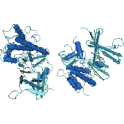
- Remove this product from my favorite's list.
- Add this product to my list of favorites.
Products
Newsletter
 |  |  |  |  |  |

Background: Extracellular signal-regulated kinase (ERK) is a serine/threonine protein kinase that functions as the major effector of the Ras protein, a small GTPase. The so called “ERK cascade” consists of three enzymes, the initial GTPase-regulated kinase Raf, (MAP3K) that phosphorylates and activates an intermediate kinase MEK (MAP2K) that, in turn, phosphorylates a threonine and a tyrosine residue of the activation loop of the effector kinase ERK (MAPK). Both, ERK1 and ERK2 share a high sequence identity (90%) and are co-expressed in most tissues but differ in their relative abundance. The substrate specificities of the ERK1 and ERK2 protein kinases are very similar. The consensus sequence for ERK1 substrates has been identified as -Pro- Leu-Ser/Thr-Pro. Both kinases are involved in proliferation, differentiation, cell cycle processes, and survival. ERK1 / 2 differentially phosphorylates a variety of nuclear (Elk-1, c-Myc), cytosolic (MNK1/2, Raf) and cytoskeletal (MAP2, Tau) targets. Since the ERK pathway is often up-regulated in human tumors it represents an attractive target for anticancer drugs development.
Human ERK2/MAPK1, recombinantly expressed in E. coli. Highly active form produced by phosphorylation of the purified ERK2/MAPK1 in vitro with MEK1 followed by subsequent affinity chromatography.
Theoretical MW: 41.76 kDa
Expression system: E.coli
Purification: Affinity purification using GSH-agarose followed by cleavage of GST-tag
Storage buffer: 50 mM Hepes, pH 7.50; 100 mM NaCl, 5 mM DTT, 20% glycerol
Storage temperature: - 80°C (avoid repeated freeze-thaw cycles!)
Shipping conditions: Dry ice
Protein concentration: 0.326 mg/ml (Bradford method using BSA as standard protein)
Method for determination of Km value & specific activity: Filter binding assay MSFC membrane
Specific activity: 386,000 pmol/mg x min
Entrez Gene ID: 5594
UniProtKB: P28482
Gonzalez FA, Raden DL, Davis RJ (1991) "Identification of substrate recognition determinants for human ERK1 and ERK2 protein kinases" J. Biol. Chem. 266(33):22159-63
Meloche S, Pages G, Pouyssegur J (1992) "Functional expression and growth factor activation of an epitope-tagged p44 mitogen-activated protein kinase, p44mapk" Mol Biol Cell 3(1):63-71
Hartsough MT, Mulder KM (1995) "Transforming growth factor beta activation of p44mapk in proliferating cultures of epithelial cells" J Biol Chem. 270(13):7117-24
Songyang Z, Lu KP, Cantley LC et al. (1996) "A structural basis for substrate specificities of protein Ser/Thr kinases: primary sequence preference of casein kinases I and II, NIMA, phosphorylase kinase, calmodulin-dependent kinase II, CDK5, and Erk1" Mol Cell Biol. 16(11):6486-93
Wortzel I, Seger R. (2011) “The ERK Cascade: Distinct Functions within Various Subcellular Organelles.” Genes Cancer. 2(3):195-209.
Kohno M, Pouyssegur J(2006).” Targeting the ERK signaling pathway in cancer therapy”. Ann Med.;38(3):200-11.
Mazzucchelli C, Vantaggiato C, Brambilla R et al. (2002) "Knockout of ERK1 MAP kinase enhances synaptic plasticity in the striatum and facilitates striatal-mediated learning and memory" Neuron 34(5):807-20
Hromadkova L, Kolarova M, Jankovicova B, Bartos A, Ricny J, Bilkova Z, Ripova D. (2015) "Identification and characterization of natural antibodies against tau protein in an intravenous immunoglobulin product." J Neuroimmunol. 15;289:121-9.
Goschzik T, Cremer H, Gnanapragassam VS, Horstkorte R, Bork K, Diestel S. (2017) "Mutation of a putative MAP kinase consensus site regulates NCAM endocytosis and NCAM-dependent neurite outgrowth."Neurosci Res. 2017 Jul;120:28-35.
Welcome Login
Contact us
Follow us